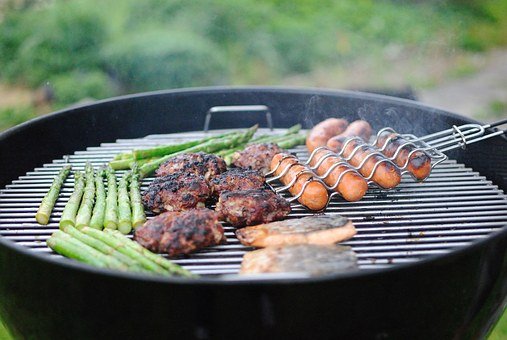Tips for a Safe and Tasty Barbecue
While there's a lot of talk about food safety in the news, it usually refers to the food before you get it home from the store. What about your summer backyard cooking? There's a lot of food handling going on between the fridge and the picnic table! Here are some of my favorite tips for keeping your outdoor BBQ safe as well as delicious!

source
PREPARING FOOD:
1. Keep it clean. Wash you hands before and after handling raw foods - with soap and water. Out at the grill? Keep some hand sanitizer handy.
2. Keep raw and cooked ingredients separate. Don't cross contaminate. Use paper plates and plastic knives when cutting up raw meat and poultry, and throw away after using.
3. Don't use the marinade from raw foods on the cooked product. Before you marinate, put some of the marinade in a separate container for use on the cooked food. Never re-use the marinade from the raw foods.
COOKING AND SERVING FOOD:
1. Start with a clean grill. Get a stiff grill brush and make sure your grill is scoured clean, with no charred black bits. Not only will your food taste better, it will avoid any harmful HCAs (heterocyclic amines) formed from the burnt bits of meat/fat from your last grilling.
2. Cook to the proper temperature to kill bacteria. The visual of "push" test for doneness doesn't work. You need to cook foods to 160 degrees, the temperature at which bacteria are killed. Even pre-cooked foods, like hot dogs, need to reach 160 degrees for optimal safety. Like Goldilocks and the 3 Bears, you don't want it too rare or too burnt. Avoid burnt meat, which forms HCAs (see above) and the related PCAs - both identified as cancer-promoting agents.
3. Buy an instant meat thermometer. That's the only way to test the temperature of your foods.
4. Keeps hot foods hot and cold foods cold. Salads, particularly with dressings, need to be kept cold. The easiest way is to take 2 glass bowls, one larger than the other. Fill the larger one with ice, and put the smaller bowl containing the salad in the ice bowl. Bacteria grow extremely well between 40 and 160 degrees. Refrigerate hot foods after 2 hours at room temperature (one hour if the outside temperature is over 80).
5. Keep it covered. Keep your platters and bowls covered, as you don't want bug dive-bombing into your foods, and running the risk of insect-born contaminants.
TRANSPORTING FOODS:
1. Buy some gel packs. The re-usable gel packs are great to put around your cold foods, when on the road. Use a Styrofoam tub, or an insulated pack to transport.
2. Cook your hot foods "on site". If you'll be on the road for awhile, consider cooking your hot dish at your host's house. Keep it cold, as above, and pop it in the oven at your destination. Otherwise, use an insulated pack for your hot dish - and the "2 hour" rule still applies. The clock is ticking from the time the dish is at room temperature - 2 hours at room temp, up to 80 degrees - and just an hour at 80 degrees or higher.